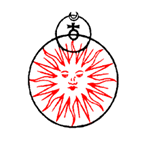De Revolutionibus Orbium Coelestium, Book 1, Chapter X
The first and the highest of all is the sphere of the fixed stars, which contains itself and everything, and is therefore immovable. It is unquestionably the place of the universe, to which the motion and position of all the other heavenly bodies are compared…
The sphere of the fixed stars is followed by the first of the planets, Saturn, which completes its circuit in 30 years. After Saturn, Jupiter accomplishes its revolution in 12 years. Then Mars revolves in 2 years. The annual revolution takes the series’ fourth place, which contains the earth… together with the lunar sphere as an epicycle. In the fifth place Venus returns in 9 months. Lastly, the sixth place is held by Mercury, which revolves in a period of 80 days.
At rest, however, in the middle of everything is the sun, For in this most beautiful temple, who would place this lamp in another or better position than that from which it can light up the whole at the same time. For the sun is called by some people the lantern of the universe, its mind by others and its ruler by still others.
| 1512 | Copernicus begins his cycle of observations of the planets with Mars. |
| 1514-1515 | Starts writing Book I |
| 1515-1516 | Observation of the Sun’s path, resulting in the discovery that the diurnal point of the Sun’s course had moved over 30 degrees since the time of Ptolemy; Copernicus’aim is to establish the magnitude of the precession and the corresponding length of the sidereal year. |
| 1515 | Discovery that the Sun’s eccentric is variable and that is apogee is moveable. |
| 1516 | Discovery of the mobility of the Earth’s apsides and of certain changes in the eccentric of its path. |
| 1519-1520 | Final editing of Book I. |
| 1523 | Completes Book II. |
| 1524 | Completes research work on the theory of the Moon. |
| 1524-1525 | Begins work on Book III. |
| 1525-1526 | Works on theory of precession (Chapters 1-14, Book III). |
| 1527 | Determines eccentric variability and apsidal motion for Saturn. |
| 1529 | Determines eccentric variability and apsidal motion for Jupiter. |
| 1530 | Completes writing Books IV-VI. |
| 1532 | Determines of eccentric variability and apsidal motion for Venus. |
| 1533 | Copernicus’ opinions presented in the manuscript of his Cook given to Pope Clement VII. |
| 1536 | 1536 Tiedeman Giese writes a treatise to defend Copernicus’ theory. |
| 1539 | Martin Luther expresses his opinion of Copernicus:“This fool wants to turn the entire science of astronomy upside down! But, as the Bible tells us, Joshua told the Sun, not the Earth, to stop in its path!” Georg Joachim von Lauchen (Rheticus), arrives at Frombork and begins his work with Copernicus to prepare the manuscript of De Revolutionibus for publication; Chapters 1-13 added to Book II, the final chapters to Book V, and Chapters 5-9 to Book VI. |
| 1540 | Makes second calculation of the period of the sidereal year. Narratio Prima (The First Account), by Georgius Joachimus Rheticus (Retyk), propagating Copernicus’ theories, published in Gdansk. Johannes Petreius, printer of Nuremberg, offers his services for the publication of De Revolutionibus. |
| 1541 | Andreas Osiander, a Nuremberg theologian, advises Copernicus to describe his discovery in the prologue to his work as a hypothesis, thereby toning down its initial impact. A second edition of Narratio Prima comes out in Basel. Copernicus performs his last astronomical observation (a solar eclipse). Rheticus leaves Frombork, taking with him the manuscript of De Revolutionibus Orbium Coelestium for publication at Nuremberg. The reformer, Phillip Melanchton, a close associate of Luther voices his opinion of Copernicus:“Some believe that to expound such an absurd matter, as that Sarmatian [Polish] astronomer has done, who would move the Earth and stop the Sun, is an excellent thing. Verily, wise governors should curb such talented rashness”. |
| 1542 | The first two folios of De Revolutionibus come off the press at Nuremberg. Copernicus sends his prologue, with a dedication to Pope Paul III, to Nuremberg. Chapters 13 and 14 of Book 1 appear as a separate book on trigonometry entitled De Lateribus et Angulis Triangulorum… Libellus (A LIttle Book on the Sides and Angles of Triangles), with a foreword by Rheticus. The Cracovian astronomer, Albert of Buków, proudly proclaims that“Nicolaus Copernicus, Canon of Warmia, who once used to live in this city, and who has drawn from this University as his principal fount for that admirable work he has already produced in the mathematical sciences which he yet intends to publish; which hi by no means denieth, yea, indeed acknowledging that for all these things he is indebted to our University”. |
| 1543 | De Revolutionibus Orbium Coelestium is published in Nuremberg. |
